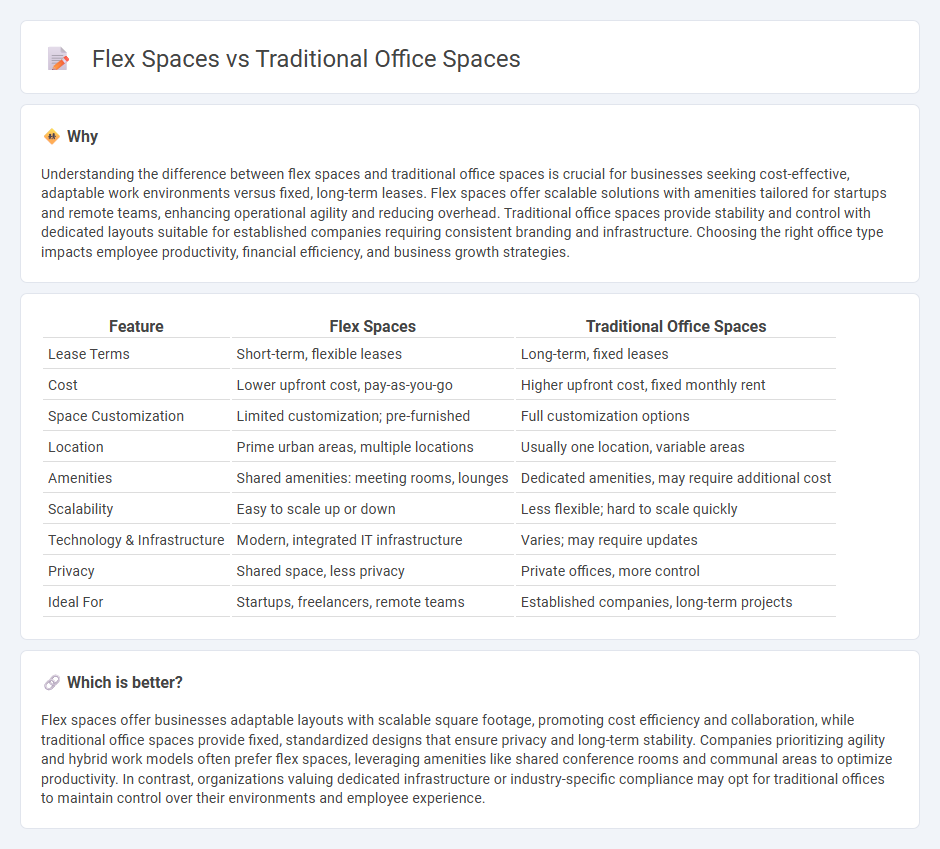
Flex spaces offer adaptable layouts and scalable lease terms that cater to dynamic business needs, contrasting with traditional office spaces known for fixed configurations and long-term commitments. These versatile environments integrate technology and shared amenities to enhance collaboration and productivity, making them ideal for startups and growing companies. Discover how flex spaces can transform your workplace strategy by exploring key benefits and industry trends.
Why it is important
Understanding the difference between flex spaces and traditional office spaces is crucial for businesses seeking cost-effective, adaptable work environments versus fixed, long-term leases. Flex spaces offer scalable solutions with amenities tailored for startups and remote teams, enhancing operational agility and reducing overhead. Traditional office spaces provide stability and control with dedicated layouts suitable for established companies requiring consistent branding and infrastructure. Choosing the right office type impacts employee productivity, financial efficiency, and business growth strategies.
Comparison Table
| Feature | Flex Spaces | Traditional Office Spaces |
|---|---|---|
| Lease Terms | Short-term, flexible leases | Long-term, fixed leases |
| Cost | Lower upfront cost, pay-as-you-go | Higher upfront cost, fixed monthly rent |
| Space Customization | Limited customization; pre-furnished | Full customization options |
| Location | Prime urban areas, multiple locations | Usually one location, variable areas |
| Amenities | Shared amenities: meeting rooms, lounges | Dedicated amenities, may require additional cost |
| Scalability | Easy to scale up or down | Less flexible; hard to scale quickly |
| Technology & Infrastructure | Modern, integrated IT infrastructure | Varies; may require updates |
| Privacy | Shared space, less privacy | Private offices, more control |
| Ideal For | Startups, freelancers, remote teams | Established companies, long-term projects |
Which is better?
Flex spaces offer businesses adaptable layouts with scalable square footage, promoting cost efficiency and collaboration, while traditional office spaces provide fixed, standardized designs that ensure privacy and long-term stability. Companies prioritizing agility and hybrid work models often prefer flex spaces, leveraging amenities like shared conference rooms and communal areas to optimize productivity. In contrast, organizations valuing dedicated infrastructure or industry-specific compliance may opt for traditional offices to maintain control over their environments and employee experience.
Connection
Flex spaces and traditional office spaces are interconnected through their complementarity in meeting diverse workplace needs, with flex spaces offering adaptable, short-term usage that supports dynamic business models and traditional offices providing stable, long-term infrastructure. Real estate developers and corporate tenants increasingly integrate flex spaces within conventional office buildings to optimize occupancy rates and enhance spatial efficiency. Market trends indicate a rising demand for hybrid leasing arrangements, reflecting a shift toward flexibility without abandoning the security of traditional office leases.
Key Terms
Lease Terms
Traditional office spaces commonly require long-term lease commitments, often spanning three to ten years, providing stability for businesses with established operations. Flex spaces offer significantly shorter lease terms, sometimes as brief as month-to-month agreements, granting adaptability for startups and companies with fluctuating space needs. Explore the advantages and flexibility options of each lease type to determine the best fit for your business requirements.
Space Utilization
Traditional office spaces often feature fixed desks and private offices that can limit efficient space utilization and reduce adaptability. Flex spaces maximize productivity by enabling hot-desking, shared work zones, and scalable layouts, optimizing both square footage and employee collaboration. Explore how flex spaces can transform your workspace strategy and enhance operational efficiency.
Amenities
Traditional office spaces often provide fixed amenities such as dedicated desks, private meeting rooms, and standard IT infrastructure tailored for long-term use. Flex spaces emphasize versatile amenities including hot desks, communal lounges, high-speed Wi-Fi, and on-demand conference rooms to support dynamic workstyles. Explore more about how amenities influence productivity and employee satisfaction in different office setups.
Source and External Links
The Advantages of Traditional Office vs Flexible Workspace - A traditional office space is a dedicated office leased or owned by a single business, often featuring private offices or cubicles, dedicated desks, and meeting rooms with a typical lease term of two years or more.
A Guide to Traditional Offices | Hubble - Traditional offices provide a structured environment with dedicated desks, private offices, and meeting spaces, offering stability, branding opportunities, and full control over the workspace, suited for businesses valuing structure and long-term planning.
Understanding the different types of office spaces - Traditional office spaces typically include a dedicated building or floor with private cabins, meeting rooms, and a reception area, offering enhanced privacy, security, and long-term stability at higher cost and lease commitments.
 dowidth.com
dowidth.com